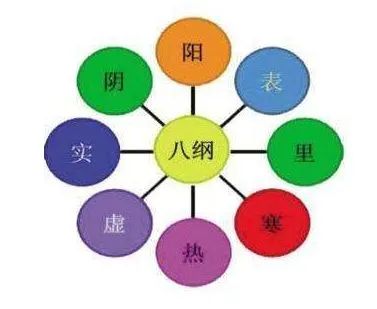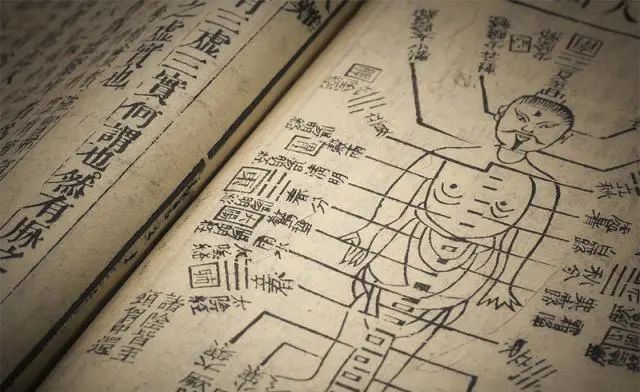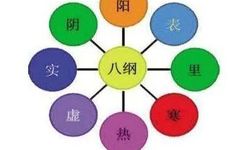
八纲辨证 (Bāi gāng biàn zhèng) is the overarching framework for various diagnostic methods in Traditional Chinese Medicine (TCM).
The Eight Principles of Diagnosis involve analyzing and identifying the symptoms of diseases, which is a primary process and method for understanding and diagnosing illnesses. 辨 (biàn) means to distinguish or analyze, while 证 (zhèng) refers to the syndrome, which is a comprehensive manifestation of the disordered relationships between the body and the environment, as well as among the organs, meridians, qi, blood, and body fluids under the influence of pathogenic factors.
Thus, clarifying a specific syndrome summarizes the pathological conditions regarding the etiology, location of the disease, the strength of the struggle between the pathogenic and righteous qi, and the relative excess or deficiency of yin and yang during the disease’s progression.
The Eight Principles include: 阴阳 (yīn yáng) (Yin and Yang), 表面 (biǎo miàn) (Exterior and Interior), 虚实 (xū shí) (Deficiency and Excess), and 寒热 (hán rè) (Cold and Heat).

The process of diagnosis is based on theories regarding the organs, meridians, qi, blood, body fluids, and etiology, and involves a comprehensive analysis of the symptoms and signs collected through the four diagnostic methods: observation, listening, inquiry, and palpation. This process synthesizes, analyzes, infers, judges, and clarifies the internal relationships and interactions among various pathological changes, thereby leading to an understanding of the disease and making an accurate diagnosis.
Diagnosis and treatment are two crucial interrelated aspects of TCM’s principles, methods, formulas, and medicines in clinical practice. Diagnosis is the understanding of the disease, while treatment involves taking appropriate therapeutic measures based on the diagnosed syndrome. Diagnosis serves as the premise and basis for treatment, while treatment is the objective and an objective standard for verifying the correctness of the diagnosis.
“症 (zhèng)” refers to individual symptoms, which are recognized similarly in both TCM and Western medicine, such as headache, fever, cough, palpitations, nausea, etc.
“病 (bìng)” refers to the disease name. In TCM, only a few disease names correspond with those in Western medicine, such as measles, diphtheria, tetanus, asthma, dysentery, and heat stroke, while most terms differ.
Due to the differing theoretical systems of TCM and Western medicine, their understanding of diseases varies. Western medicine’s understanding is based on human anatomy and pathophysiology, with clinical diagnosis relying on the patient’s subjective symptoms, physical examination, and laboratory tests. In contrast, TCM views diseases as results of imbalances in yin and yang, with clinical diagnosis primarily based on the patient’s symptoms and signs (such as tongue and pulse diagnosis), without necessarily identifying a disease name but rather clarifying the specific “证 (zhèng)”.
“证 (zhèng)” is an abbreviation for evidence or syndrome; it is not merely a symptom or subjective feeling but a group of syndromic manifestations. It is TCM’s diagnostic concept of disease. “证” encompasses a set of specific clinical manifestations (symptoms, signs, etc.) and includes comprehensive concepts regarding etiology, location of the disease, nature of the pathological changes, and the comparative strength of the righteous and pathogenic qi. “证” is derived from analyzing symptoms and signs and is a concept that better explains the essence of the disease than mere symptoms.

TCM diagnosis has been developed through long-term clinical practice, employing various methods, primarily including the Eight Principles of Diagnosis, etiology-based diagnosis, qi and blood diagnosis, organ diagnosis, defensive qi, nutritive qi, and blood diagnosis, triple burner diagnosis, and six meridian diagnosis. Among these, the Eight Principles of Diagnosis serve as the overarching framework for all diagnostic methods.
The Eight Principles of Diagnosis are based on the materials obtained from the four diagnostic methods, conducting a comprehensive analysis to explore the nature of the disease, the location of the pathological changes, the severity of the disease, the strength of the body’s response, and the comparative strength of the righteous and pathogenic qi, categorizing them into eight types of syndromes: 阴 (yīn), 阳 (yáng), 表 (biǎo), 里 (lǐ), 寒 (hán), 热 (rè), 虚 (xū), and 实 (shí). This is a fundamental method of TCM diagnosis, encompassing the commonalities derived from the individuality of various diagnostic methods, playing a role in simplifying complex disease presentations and summarizing key points during the diagnostic process.
Although the manifestations of diseases are extremely complex, they can generally be categorized within the Eight Principles. The overall categories of diseases include two major types: 阴证 (yīn zhèng) (Yin syndromes) and 阳证 (yáng zhèng) (Yang syndromes); the depth of the disease can be classified as 表 (biǎo) (exterior) or 里 (lǐ) (interior); imbalances in yin and yang, with yang excess or yin deficiency leading to 热证 (rè zhèng) (heat syndromes), and yang deficiency or yin excess leading to 寒证 (hán zhèng) (cold syndromes); the strength of the pathogenic and righteous qi, with strong pathogenic qi termed 实证 (shí zhèng) (excess syndromes) and weak righteous qi termed 虚证 (xū zhèng) (deficiency syndromes).

Therefore, the Eight Principles of Diagnosis analyze the ever-changing diseases according to the simple dichotomies of exterior and interior, cold and heat, deficiency and excess, yin and yang, revealing the contradictions within the pathological changes, thus capturing the essence of whether the condition is exterior or interior, cold or hot, deficient or excessive, and belongs to yin or yang. This embodies the fundamental spirit of the Eight Principles.

Source: Online article. We focus on sharing; the articles and images are sourced from the internet, and the copyright belongs to the original authors. If there are any objections, please inform the editor, and we will promptly delete it.

